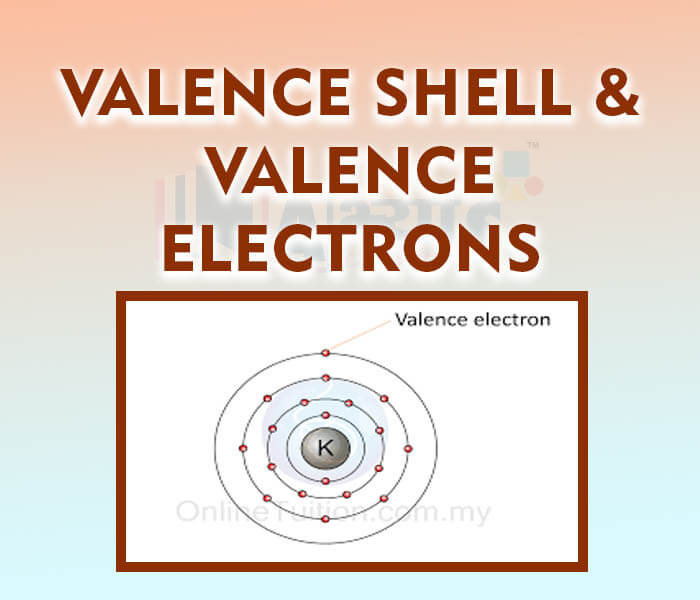Valence Shell and Valence Electrons










Valence Shell and Valence Electrons
Valency: The electrons present in the outermost shell of an atom are known as the valence electrons. They govern the chemical properties of atoms. The atoms of elements having completely filled outermost shell which has eight electrons (said to possess an octet) show little chemical activity, i.e. they are highly stable. Such elements are called inert elements. It means, their valency is zero.
Of these inert elements, the helium atom has two electrons in its outermost shell and all other elements have atoms with eight electrons in the outermost shell. The tendency to react with atoms of the same or different elements to form molecules is an attempt to attain fully-filled outermost shell. It means, atoms react with other atoms in order to attain fully-filled outermost shell. An outermost shell, which had eight electrons, is called an octet.
Atoms would thus react, so as to achieve an octet in the outermost shell. This was done by sharing, gaining or the loss of electrons. The number of electrons lost or gained or shared by an atom to become stable or to achieve an octet in the outermost shell is known as valency of that element. In other words, it is the combining capacity of the atom of an element with the atom(s) of other element(s) in order to complete its octet. The valencies of elements of some groups are described below:
1. atoms contain one electron each in their outermost shell, therefore, each one of them can lose one electron to become stable and form cations like
. Hence, their valency is 1.
2. The valency of each of is 2 because all of these have 2 valence electrons and they can lose these 2 electrons to make cations like
.They lose electrons to form octet of electrons in the outermost shell or to become stable.
3. The valency of is 3 because each has 3 valence electrons.They can lose electrons to become stable and can form cations like
.
4. The valency of is 4 because each has 4 valence electrons. These atoms can lose or gain 4 electrons to form either a cation or an anion. Eg:
. Carbon usually form covalent bonds by sharing of electrons.
5. each has 5 valence electrons, so their valency is 3 because they can gain 3 electrons (instead of losing five electrons) to become stable. Hence, their valency is determined by subtracting five electrons from the octet i.e. 8-5 = 3. However, P can also share 5 electrons; hence it shows a valency of 5 alongwith 3. It results in formation of
(nitride),
(nitrogen),
(phosphorus) and
(phosphide).
6. and
each has 6 valence electrons, therefore, their valency is 2 because they can gain 2 electrons or share 2 electrons to complete their octet.Eg:
7. Similarly, each has 7 valence electrons, their valency is 1 because they can gain 1 electron or share 1 electron to complete their octet. Eg:
8. All the inert elements, i.e. etc., have completely filled outermost shells. Therefore, their valency is zero.
Note: For metals, generally valency = Number of valence electrons, for non-metals, valency = 8- number of valence electrons.
The ratio of number of electrons present in four shells of an element is 1:4:4:1, Fourth shell is the valence shell. Then mass of total positive charge present in the atom is _____ times to that of mass of electron? | |||
| Right Option : A | |||
| View Explanation | |||
What is the maximum number of electrons that can be accomodated in the outermost orbit? | |||
| Right Option : B | |||
| View Explanation | |||
Which of the following elements is chemically inactive? | |||
| Right Option : B | |||
| View Explanation | |||
Students / Parents Reviews [10]
It was good as the experience because as we had come here we had been improved in a such envirnment created here.Extra is taught which is beneficial for future.

Eshan Arora
8thI have spent a wonderful time in Abhyas academy. It has made my reasoning more apt, English more stronger and Maths an interesting subject for me. It has given me a habbit of self studying

Yatharthi Sharma
10thAbhyas Methodology is very good. It is based on according to student and each child manages accordingly to its properly. Methodology has improved the abilities of students to shine them in future.

Manish Kumar
10thIt has a great methodology. Students here can get analysis to their test quickly.We can learn easily through PPTs and the testing methods are good. We know that where we have to practice

Barkha Arora
10thBeing a parent, I saw my daughter improvement in her studies by seeing a good result in all day to day compititive exam TMO, NSO, IEO etc and as well as studies. I have got a fruitful result from my daughter.

Prisha Gupta
8thAbhyas is a complete education Institute. Here extreme care is taken by teacher with the help of regular exam. Extra classes also conducted by the institute, if the student is weak.

Om Umang
10thMy experience with Abhyas is very good. I have learnt many things here like vedic maths and reasoning also. Teachers here first take our doubts and then there are assignments to verify our weak points.

Shivam Rana
7thOne of the best institutes to develope a child interest in studies.Provides SST and English knowledge also unlike other institutes. Teachers are co operative and friendly online tests andPPT develope practical knowledge also.

Aman Kumar Shrivastava
10thMy experience was very good with Abhyas academy. I am studying here from 6th class and I am satisfied by its results in my life. I improved a lot here ahead of school syllabus.

Ayan Ghosh
8thIt was a good experience with Abhyas Academy. I even faced problems in starting but slowly and steadily overcomed. Especially reasoning classes helped me a lot.
